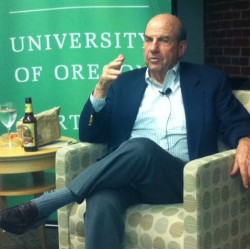Blog:
Low-tech, high impact: Storytelling with Calvin Trillin

Writer Calvin Trillin visiting the University of Oregon

The evolution of news media means journalists can tell stories many ways quickly: through tweets, posts, live chats, short video takes or breaking-news blogging that’s refreshed by the minute.
But with the advent of 140-character updates, the future of 3,000-word long-form stories is uncertain.
Last week, the JA listened in as Calvin Trillin, a modern master of long-form narrative nonfiction, spoke with journalism professionals, students and scholars from nearby universities at the University of Oregon’s Turnbull Center in Portland.
Moderated by author and professor Lauren Kessler, the conversation held gems for journalists and publishers looking to keep a place for deeply told stories in our fast-take, short-form world.
Gone are the days when a newspaper reporter easily gets 200 inches for an in-depth feature. But multimedia may bring a new demand for and new ways of experiencing long-form narrative stories. BuzzFeed, a website known for “breaking buzz” and tracking viral memes, recently dove into the long-form world with an in-depth story on the history of videogames, presented with bright pictures and old-school animation. Other outlets, such as The Atavist and Amazon Kindle Singles sell long-form, magazine-style stories for as low as $0.99.
The Turnbull Center

The University of Oregon is based in Eugene, but its George S. Turnbull Center brings an academic journalism center to the Portland waterfront. The center is intended to be “an incubator for innovative ideas about the future of journalism and strategic communications…a forum where communication educators, students, researchers, practitioners, and citizens mix.”
Turnbull is home to the U of O’s new Masters in Multimedia Journalism program. It also plays host to programs connecting undergrads to journalism professionals in Portland and holds discussions, workshops and other events for the public and the journalism community.
At an evening with writer Calvin Trillin last week, Lauren Kessler, who directs the University of Oregon’s Master’s in Multimedia Journalism program, based at the Turnbull Center, said there is so much noise in the media now that people “hunger for” and “immediately glom on to” writers who offer a distinct voice.
“The intelligent but not high-falutin’ voice,” she said in her introduction to Trillin. “The witty but not snarky voice. The quirky-but-not-insistently-so voice. I think we listen to that voice regardless of subject. We might, in fact, read an entire book about finding parking spaces in Manhattan just to listen to that voice.”
Trillin wrote a 213-page novel about the New York parking life of a man dubbed Murray Tepper. A former staff writer for The New Yorker, prolific contributor to The Nation and the author of nearly 30 nonfiction books, Trillin may well have written something on possibly close to everything.
Trillin sipped a microbrew as he spoke to journalism students, professors and practitioners at Turnbull. Kessler praised his focus on the “narrative line” over the “dramatic story” and his ability to create journalism that is “both important and entertaining simultaneously.” We mined the conversation for tidbits valuable to writers and publishers with perhaps less time, but similar values. Or for anyone interested at a peek inside one great writer’s head.
Trillin on technology: “I’m not really a good person to ask about technology. I’m always three technologies behind. I have a cassette deck in my car.
“When I did that series around the country, I thought the biggest technological breakthrough for me was when places started to have copy shops, which are now gone. A place where I could take in a trial transcript or a bunch of clippings and say, ‘I’ll be back in a few hours to pick them up.’”
Trillin on “parachuting in” for a story: “In these 3,000-word pieces I tended to stay roughly a work week (in a city) working on the story. I think there are advantages to coming in from the outside, in what used to be called ‘parachute journalism.’ But, there’s some disadvantages, obviously. In certain ways, you’ll never know as much as the local beat reporter. … You’re always a stranger. On the other hand, you’ll catch things that other people have sort of absorbed.

University of Oregon journalism students were among those hearing wit and wisdom from writer Calvin Trillin. Credit: Lisa Skube
“I don’t think I ever left thinking, ‘There’s really an important part of this story I’m not getting.’ And I don’t think I’m that aggressive of a reporter, but I think if you talk to enough people … In the first place, everyone has a different idea of what part is secret. So if you talk to enough people, you generally know enough to write the story.”
Trillin on fact-checking: “I’m very big on the fact-checkers, even when they irritate me. There are reporters who are dismissive of fact-checking departments, and I think they’re either lazy reporters or liars. Because why would anybody be anything but grateful for somebody cleaning up after you?
“The point…is to get things to the best of your ability right….After that, you can be poetic if you want to.”
Trillin on the future: “I don’t think anybody knows what’s going to happen to long-form journalism. Certainly, it doesn’t seem to be a good period for magazines.
“I’ve always thought reporters were sort of the last to know about the global issues of journalism.”
Are you writing long-form stories these days? How do you present them? What brings the most response from your community?










Weigh In: Remember to refresh often to see latest comments!
0 comments so far.